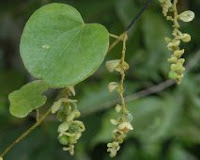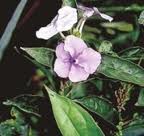My teacher don Roberto Acho is well known as a sananguero — that is, an expert in the use of a group of plants collectively known as sanango. The best known of these plants is chiricsanango (Brunfelsia grandiflora).
In fact, there are two primary Brunfelsia species, B. grandifloria and B. chiricaspi. Both of these plants are called chiricsanango; but the first is also called chuchuhuasha, and the second is also called chiricaspi. Note that chuchuhuasha is a different plant from chuchuhuasi (Maytenus macrocarpa), although understandably their names are sometimes confused. Note that the Quechua term chiric, cold, chills, appears in the name of both chiricsanango and chiricaspi.
Just to add to the confusion, the poet César Calvo distinguishes — on what basis I do not know — between red and white chuchuhuasha.
 |
| Motelosanango (Abuta grandifolia) |
But wait! There is more confusion. The sanangos include not only chiricsanango but also motelosanango (Abuta grandifolia); a variety of species in the genus Tabernaemontana, called, without much consistency, lobosanango, uchosanango, or yacusanango; a variety of species in the genus Bonafousia, called cocasanango or sanango macho; and a variety of species in the genus Faramea, called caballosanango or, again, yacusanango. Just about any of these species may be called, simply, sanango.
It is not clear to me what these plants have in common. Chiricsanango causes chills and tingling when ingested, and is thus considered a cold plant, used to treat hot conditions — fever, diarrhea, wounds, and inflammations. Motelosanango is a hot plant, which has, as mestizo shaman Manuel Córdova says, “the effect of warming the blood,” and is thus used to treat cold conditions, such as arthritis, rheumatism, and erectile dysfunction. I can detect no overriding physical resemblance among the sanangos; for example, look at a picture of motelosanango on the left, above, and chiricsanango on the right.
 |
| Chiricsanango (Brunfelsia grandiflora) |
I would be very grateful if anyone could straighten this out for me.
Putting all this confusion aside, there is no doubt that chiricsanango is a powerful plant. The medicine is made as a decoction of the leaves or bark, or as an infusion of the roots. The plant contains an alkaloid named scopoletin, but the effects of scopoletin are very different from those of the scopolamine in toé. The effect of ingesting chiricsanango can be dramatic — a tingling and vibrating sensation in the extremities, moving inward toward the head with ever-increasing intensity; periodic waves of cold; tremors, electric vibrations penetrating the chest and back, stomach cramps, nausea, dizziness, vertigo, loss of coordination.
It is thus not at all clear to me whether chiricsanango has an independent psychoactive effect, or whether altered consciousness is a result of its powerful physical effects; scopoletin is not itself known to be psychoactive. But there is no question that chiricsanango is a very powerful ally, a healer, a strong protector, once it has shaken your bones.

- Previous Post: Male Potency Enhancers
- Next Post: The Smell of the Jungle
- More Articles Related to: Plant Medicine, Sacred Plants, The Amazon



My teachings from Valentin, MD., neurosurgeon, psychiatrist and shaman…
We used chiric sanango foremost as a nerve tonic. I often put this in my ayahuasca and can feel it’s calming effects on my nerves. Taken alone, sipped very slowly and stopping the moment you feel the sensations in your lips and fingers, makes for an excellent medication. If you don’t stop, it can kill you. This is a plant, as is datura and toe, that is not to be played with. Very powerful and is one of the plants that I always suggest people diet with, but not the first one. It’s a master.
Hi Alan, nice to meet you here!
I did my first plant diet with Virginia, with Chiric Sanango, only 3 days, wished I did longer but had to leave.
I really loved that tingling sensation, I felt like a universe with all its stars getting born and dying, then got really strong insights.
But since I have a rash on the all right side of my back, it s now a good 3 weeks. It comes more out when I feel warm (sweating, hot shower).
Soon I ll go back to my island in the Caribbean, so 2 solutions: or it will go worst with the heat, or I have a feeling it will go away when swimming in the ocean…
Do you know anything about that, why, how…?
Thanks and happy day, Estelle
Hi Steve
I definitely agree that it is an important and interesting plant. I can certainly attest to the uncanny and disorientating effects of chiricsanango – unable to walk in a straight line more than a few steps, having said that there is no sense of intoxication whatsoever, but physical coordination certainly goes haywire. I’ve also had floral baths with the leaves which gives a massive ‘itching’ sensation all over; scratching doesn’t help as there is nothing to scratch!
The other stimulating effects which I experience when dieting this plant, is that the body heats up a lot, and at times I need to cool off by taking a dip in the river. The ‘warming’ effect also plays out on an emotional and psychological level, as just as it warms up a cold body, it also warms up a ‘cold’ heart and feelings, so without actually wanting to, I find myself ‘warming’ to and liking people….. I actually don’t like! This plant is a great and magical teacher without any doubt.
Saludos
Howard
My mother has osteoarthritis that has caused degeneration of her spine and that in turn puts stress on the nerves causing her to be in constant pain. After much research, i concluded that chiricsanango might be a good medicine for her. I have found a store where I can purchase it in the US and make a tea of it for her. I was wondering if anyone can help me calculate the proper and non-toxic dose. I would have loved to take her to Peru but she does not want to travel at this time. I greatly appreciate all the help I can get. Thank you for your time.
Roxana,
Why chiricsanango and not chuchuhuasi? Chuchuhuasi is know to improve posture and arthritis, and it might more effectively treat the underlying cause of what your mother is going through.
I tried another sanango, they called ushpa washpa sanango, a tea that tastes like pig´s caca… 3 big cups per day, 10 days diet, only yuca, in the jungle. The promised virtue is to make you have a very important dream. I had mine, after only 3 days. And became vegetarian since then.
Peru, Chasuta, 2005.